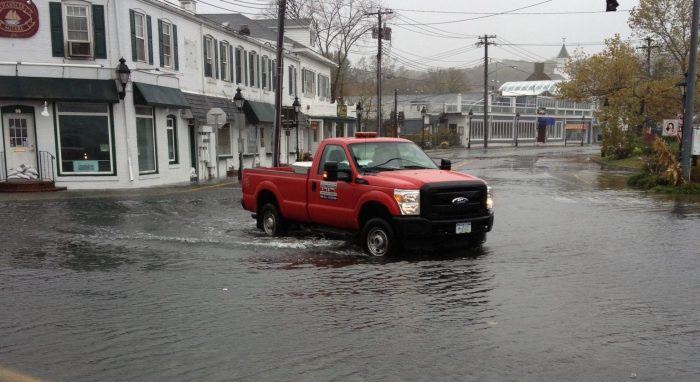D. None of the Above: Nine years later, New York isn’t ready for another Sandy
By Daniel Dunaief

Nine years ago, Superstorm Sandy came roaring through the area, causing flooding, knocking out power and disrupting work and school.
All these years later, New York is not prepared for other significant storms, despite studies suggesting that future, slow moving hurricanes with heavy rain could overwhelm infrastructure in and around Long Island.
“While we have dithered, New Orleans, Houston and other U.S. cities have gained federal support for regional protection strategies — which will be funded with our tax dollars,” according to an information packet created by the New York New Jersey Storm Surge Working Group. “We can’t waste another decade pursuing local responses to regional threats.”
In a ninth anniversary boat tour designed to address the challenges from a future Sandy or even a Hurricane Ida, the working group, which is chaired by School of Marine and Atmospheric Sciences Distinguished Professor at Stony Brook University Malcolm Bowman, outlined four messages.
First, the group suggested that coastal flooding presented a significant danger. Storm surge, sea level rise and storm water from extreme rain present an “existential threat” to the area.
Second, the group concluded that coastal flooding is a regional challenge that requires a regional solution. These scientists urge the two middle Atlantic states to consider creating a layered defense system, which they argue would be cost effective to protect property and the environment.
Third, and perhaps most damaging, the group concludes that the area is as vulnerable now as it was nine years ago in the days before Hurricane Sandy arrived. The group wrote that “no regional costal resilience plan” is in place to protect over 1,000 miles of the New York and New Jersey metropolitan coastline.
Fourth, the changing political climate presents an opportunity to do something. The group highlighted how a new governor of New York, the start of a new term or releected governor in New Jersey, a new mayor of New York City and the restarting of the $20 million New York and New Jersey Harbor and Tributaries Focus Area Feasibility Study, or HATS, presents a “once in a lifetime opportunity to act now to address the existential threat of costal flooding with a regional coastline resilience system that meets our social justice, environmental justice, quality of life and economic development goals.”
Bowman urged New York and New Jersey residents to consider the progress other states and countries have made.
“Houston is going ahead,” Bowman said, even while New York hasn’t taken any significant steps.
Bowman said part of the challenge in creating any change that protects the area comes from the lack of any enduring focus on a vulnerability that isn’t evident to residents on a daily basis.
“People have short memories,” Bowman said. “It’s not on their minds” even if they endured the disruption and devastation from storms like Sandy and Ida.
Necessity and the lack of deep pockets in other countries is the mother of invention.
“A lot of countries can’t afford” to rebuild the way New York and New Jersey did after Hurricane Sandy,” Bowman said. “They are forced to be more careful.”
Bowman said any major project to protect the area needs a hero who can tackle the details, navigate through the politics and execute on viable ideas.
The late Daniel Patrick Moynihan had “that kind of charisma,” Bowman said. “We need somebody who everybody sees as the hero. I don’t see that person” at this point.
For New York and New Jersey, the longer time passes without any protective measures, “the more the danger will increase,” Bowman cautioned.







